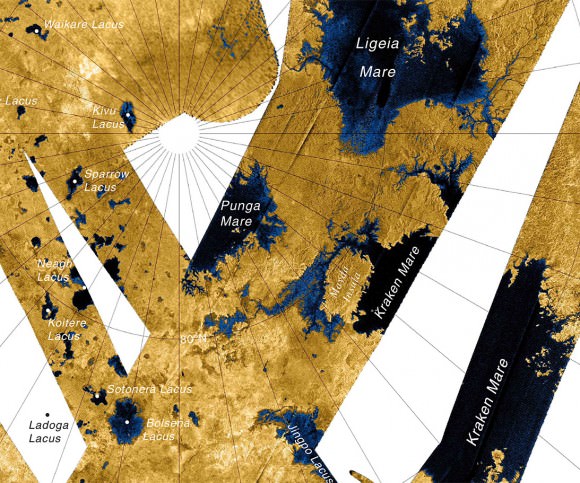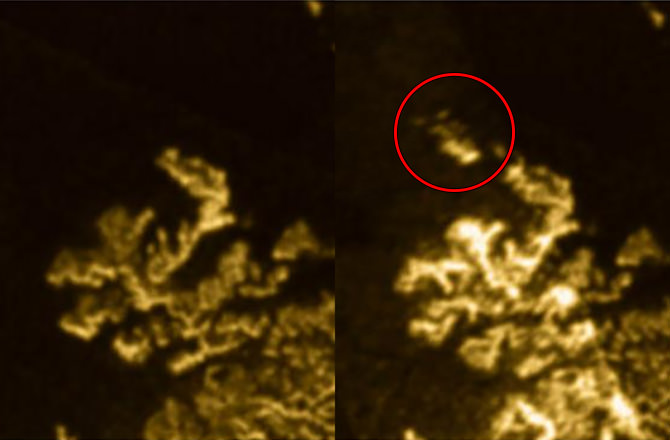Astronomers with the Cassini mission have detected a bright, mysterious geologic object on Saturn’s moon Titan that suddenly showed up in images from the mission’s radar instrument. The object appeared in Ligeia Mare, the second-largest sea Titan. The feature looks like an island and so the team named it “Magic Island.” However, it most likely is not an island that suddenly surfaced. But scientists say this may be the first observation of dynamic, geological processes in Titan’s northern hemisphere.
The object suddenly showed up in images beamed back from Cassini on July 10, 2013, showing regions of Ligeia Mare, a sea located near Titan’s north pole. But then just as suddenly, in a follow-up flyby only days later on July 26, the island was gone. Subsequent flybys confirmed that Magic Island had vanished and is what is known as a “transient feature.”
“This discovery tells us that the liquids in Titan’s northern hemisphere are not simply stagnant and unchanging, but rather that changes do occur,” said Jason Hofgartner, a Cornell graduate student in the and the lead author of a paper appearing in Nature Geoscience. “We don’t know precisely what caused this ‘magic island’ to appear, but we’d like to study it further.”

Titan is currently the only other world besides Earth known to have stable bodies of liquid on its surface. But unlike Earth, Titan’s lakes aren’t filled with water — instead they’re full of liquid methane and ethane, organic compounds which are gases on Earth but liquids in Titan’s incredibly chilly -290º F (-180º C) environment.
So what was this object? Among the explanations from the team are:
- Northern hemisphere winds may be kicking up and forming waves on Ligeia Mare. The radar imaging system might see the waves as a kind of “ghost” island. Scientists previously have seen what they think are waves in another nearby Titan sea, Punga Mare.
- Gases may push out from the sea floor of Ligeia Mare, rising to the surface as bubbles.
- Sunken solids formed by a wintry freeze could become buoyant with the onset of the late Titan spring warmer temperatures.
- Suspended solids in Ligeia Mare, which are neither sunken nor floating, but act like silt in a terrestrial delta.
“Likely, several different processes – such as wind, rain and tides – might affect the methane and ethane lakes on Titan. We want to see the similarities and differences from geological processes that occur here on Earth,” Hofgartner said. “Ultimately, it will help us to understand better our own liquid environments here on the Earth.”
Source: Cornell University


Maybe these are images of low and then high tide?
From Saturn’s gravity?
So, just how large is (was) Magic Island?
It looks like a wet season vs dry season thing to me.
I agree with gopher. When comparing the 2 pictures, the right one has brighter returns, presumably from the peaks or drier areas, and the coastline has been revealed like a tide. A 16 day lapse in Cassinis 2nd overflight might indicate a change in weather has happened.
Either way, I would put more weight behind the theory of liquid ebbing and rising rather than sudden dramatic geologic change.
Ofcourse we all know this is Goldfngers secret island and that indeed our world is doomed by the certainly evil plot engineered by this raving lunatic. Dammit Bond…get the job done!
Comparing the two images, I see several geologic features that have changed. The appearance of “Magic Island” is certainly the first to jump out at you. But if you look carefully at other areas of the images, you’ll see several changes, some of which are nearly as dramatic as the appearance of Magic Island.
Yes Gerald I saw the other changes as well it could be tidal pull from Saturn because the liquid levels are not the same in the 2 photo shots, unless the pull is so strong its moving undermethane (not underwater) mountains just enough to break the surface.
It’s the Giant Squid of Titan! The head is to the bottom right, and the tentacles to the top left. And it’s waving to us. Yay, first contact!